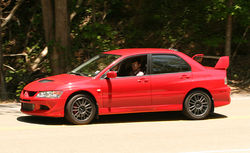Blog Archive
 | |
| Production | January 2003–March 2005 |
|---|---|
| Platform | CT9A |
| Transmission(s) | 5-speed manual 6-speed manual |
| Wheelbase | 2,625 mm (103.3 in) |
| Length | 4,490–4,535 mm (176.8–178.5 in) |
| Width | 1,770 mm (69.7 in) |
| Height | 1,450 mm (57.1 in) |
| Curb weight | 1,320–1,410 kg (2,910–3,109 lb) |
The Lancer Evolution VIII MR uses slick-response Bilstein shocks for improved handling. The aluminium roof panel and other reductions in body weight have lowered the centre of gravity to produce more natural roll characteristics. Detail improvements have also been made to Mitsubishi’s own electronic all-wheel drive, to the ACD 5 + Super AYC 6 traction control, and to the Sports ABS systems. The Lancer Evolution VIII displayed at the 2003 Tokyo Motor Show took the MR designation traditionally reserved for Mitsubishi Motors high-performance models (first used for the Galant GTO). Other parts on the MR include BBS alloy wheels, the aforementioned Bilstein shocks, and an aluminium roof. In the United Kingdom, many special Evolutions were introduced, including the FQ300, FQ320, FQ340, and FQ400 variants. They came with 305, 325, 345, and 405 hp (227, 239, 254 and 298 kW), respectively. It is rumoured that the 'FQ' stands for 'Fucking Quick'.[4][5]
The FQ400, sold through Ralliart UK, produces 411 PS (302 kW; 405 hp) from its 2.0 L 4G63 engine, the result of special modifications by United Kingdom tuning firms Rampage Tuning, Owen Developments, and Flow Race Engines. At 202.9 hp (151.3 kW) per litre, it has one of the highest specific outputs per litre of any roadcar engine. With a curb weight of 1,450 kg (3,197 lb), it achieves 0-60 mph in 3.5 seconds, 0-100 mph in 9.1 seconds, 1/4 mile in 12.1 seconds at 118 mph (190 km/h), and a top speed of 175 mph (282 km/h) while costing £47,000. BBC's television series Top Gear demonstrated that the stock FQ-400 could surprisingly keep up with a Lamborghini Murciélago around a test track. The Stig recorded a Top Gear Power Lap Times of 1 minute and 24.8 seconds, 1.1 seconds slower than the Murciélago's time of 1 minute 23.7 seconds.[6] In a similar test conducted by Evo magazine, the Evolution was able to lap the Bedford Autodrome faster than an Audi RS4 and a Porsche 911 Carrera 4S.
The Lancer Evolution VIII was also the first Evolution to be sold in the United States,[7] spurred by the success of the Subaru Impreza WRX which had been released there just three years prior.[2] The Evolution VIII found its true competition in the Subaru Impreza WRX STI model the same year as the Evolution VIII's US introduction. However, the internal components for the American versions were largely stripped-down versions of the specifications for the Japanese Lancer Evolution VIII. No US-spec Evolution model prior to the Evo X has active yaw control, including the 2006 Evolution IX. The American 2003 and 2004 GSRs are without the helical limited-slip front differential and 6-speed manual transmission. The 2004 US spec RS models, however, do have a front helical limited-slip differential. All 2003, 2004 and 2005 RS and GSR models have the Japanese Evolution VII's 5-speed transmission. The MR edition was introduced to the US in 2005, with ACD and the only model with a 6-speed transmission. The 2005 US spec RS and GSR have the ACD standard, and the front helical limited-slip differential is now standard on all models. The boost, timing, and tuning are also significantly lower than its Japanese counterpart, allowing it to adhere to the strict emissions regulations of the United States. Starting in 2005, the US model Evos were also fitted with a 5000rpm limit on launching in 1st gear to protect the drivetrain.
Most Evolution VIIIs have a carbon fiber rear spoiler with matching body-color endplates. Furthermore, the US versions of the Lancer Evolution VIII 2003-2005 were given bulkier rear bumpers than their Japanese counterparts to accommodate US safety laws in the form of the metal rear crash bar. All Evos have lightweight aluminum front fenders and hoods. MR and RS editions have an aluminum roof. Additionally, MR Editions come equipped with a 6-speed transmission, Bilstein shocks, and factory optional BBS wheels.
The basic RS Edition does not come with power windows, locks, or mirrors, an audio system, rear wing, sound deading material, map lamps or an anti-lock braking system. All Evo VIII RS models sold in the US have an air conditioning system. Power windows, locks, and audio systems could be had in the RS model through the addition of the "Urban Jungle" comfort package.[8]

Label
- Alkitab (5)
- anime (14)
- Arti nama (3)
- Automotif (138)
- Award (1)
- Bahaya (1)
- Bangunan Unik (8)
- belajar html (1)
- benda (24)
- Binatang (36)
- Biografi (81)
- Biologi (6)
- buah (12)
- cara belajar (2)
- CIA (1)
- Community (2)
- contact (1)
- Daerah (18)
- Dewa (2)
- Dijual (1)
- Download software (5)
- drift (1)
- Ekonomi (1)
- FBI (1)
- film (33)
- Fisika (11)
- Game (37)
- ganti kusor blog (1)
- Geografi (27)
- hacker (7)
- Hewan Punah (5)
- Ilmu (48)
- ilmu Beladiri (4)
- Istilah (5)
- kata kata bijak (2)
- kata2 bijak (1)
- Kecepatan (14)
- kimia (1)
- kisah nyata (6)
- Komputer (7)
- Kristen (4)
- kuno (6)
- LAPD (1)
- link (2)
- lirik lagu (3)
- membuat virus (1)
- membuat virus melalui notepad (1)
- membuat virus via notepad (1)
- Misteri (67)
- Misteri dunia (51)
- Mitos (10)
- NASA (88)
- negara (5)
- Organisasi (2)
- Parkour (1)
- Pelajaran (1)
- Perjalanan (1)
- Perkembangan (2)
- petshop (9)
- petugas (1)
- PKN (3)
- pohon (5)
- Puisi (1)
- pulau (9)
- Rahasia (1)
- rubic (2)
- Saion (1)
- sastra (3)
- sejarah (29)
- Senjata (73)
- situs populer (7)
- Sniper (1)
- tata surya (27)
- Teknik (15)
- telepati (1)
- Tenga dalam (1)
- the power of kepepet (1)
- The Three Kingdom (8)
- TIps Binatang (10)
- Tips blogger (4)
- tradisi (9)
- tragedi (4)
- trick magic (2)
- Tumbuhan (1)
- UFO (1)
- Yesus (2)
Loading
Tian's Fan Box
Tian on Facebook
Copyright 2010 Tian
Theme designed by Lorelei Web Design
Blogger Templates by Blogger Template Place | supported by One-4-All





0 komentar:
Posting Komentar